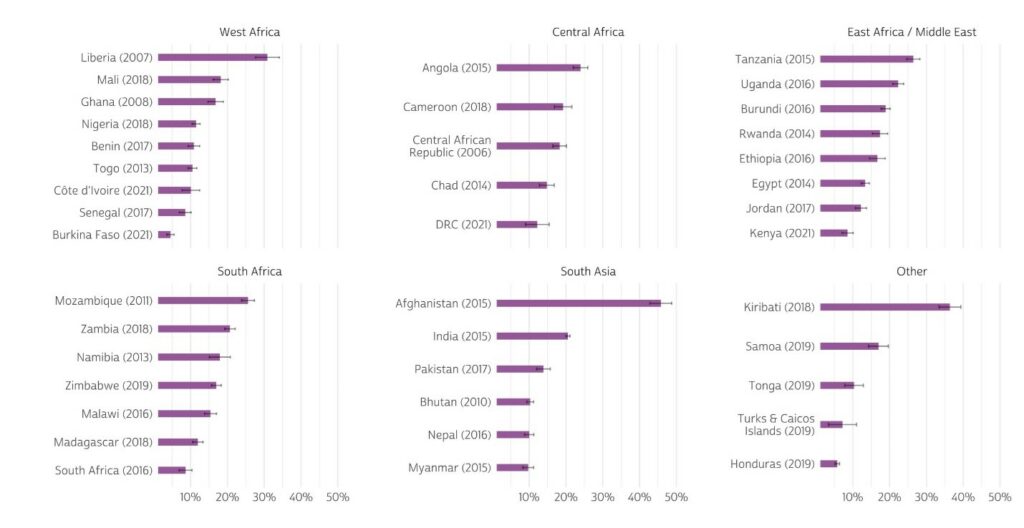By Miriam King, Anna Bolgrien, Mehr Munir, and Devon Kristiansen
The three data series comprising IPUMS Global Health—IPUMS DHS, IPUMS PMA, and IPUMS MICS—contain intersecting subjects related to women’s and children’s health, while retaining distinct patterns of temporal and geographic coverage. This content overlap opens the door to combining harmonized data across the three surveys, to extend time series and/or increase the number of countries in comparative analyses. However, there are important yet subtle differences between these survey types, in sample frames, questionnaire wording, and variable responses and universes, which require cautious consideration. As the example below demonstrates, researchers must use extra care to avoid errors when combining data across IPUMS DHS, MICS, and PMA.
A July 2024 article in the Journal of Public Health Policy, “Constructing Comparable Intimate Partner Violence Indicators across DHS, MICS, and PMA Health Surveys,” describes some challenges and solutions to combining data across these IPUMS databases, using measures of intimate partner violence as an example. The piece, authored by Devon Kristiansen and colleagues at IPUMS, notes two necessary steps in combining data across survey types:
- Identify and combine only variables with similar question wording
- Adjust the samples to include only comparable subpopulations
As the article explains, achieving comparability for this research question required limiting the sample to currently married and cohabiting women who were asked about their experience of domestic violence in the past 12 months. The authors reviewed dozens of domestic violence variables and combined responses from a few with comparable content to create single indicators of recent emotional abuse, physical abuse, and sexual abuse. The requisite code to adjust the sample composition and create these indices is posted on the IPUMS Github site. Along with tackling methodological issues, the article documents considerable variability across countries in the percent of currently partnered women who experienced physical intimate partner violence in the past 12 months (see Figure below).
IPUMS DHS and PMA include dozens of variables related to domestic violence, and a broad range of domestic violence variables have just been released by IPUMS MICS. The table below documents broad categories of domestic violence variables available in the three data collections. Researchers who wish to combine data from this broader range of domestic violence topics across survey types need to exercise similar care in limiting the sample and choosing comparable variables.
Table 1. Domestic violence topics by survey
| Attitudes towards domestic violence | Domestic violence from familial and non-family actors | Consequences of domestic violence | Help-seeking | |
|---|---|---|---|---|
| IPUMS DHS (Women age 15-49) | IPUMS DHS Attitudes | IPUMS DHS Partner IPUMS DHS Other than partner IPUMS DHS Violence while pregnant | IPUMS DHS Consequences of domestic violence | IPUMS DHS Help-seeking |
| IPUMS PMA (Family Planning-Person) | IPUMS PMA Partner IPUMS PMA Other than partner IPUMS PMA In the community | IPUMS PMA Help-seeking | ||
| IPUMS MICS (Women age 15-49) | IPUMS MICS Attitudes | IPUMS MICS Partner IPUMS MICS Other than partner IPUMS MICS Violence while pregnant | IPUMS MICS Help-seeking |
Looking ahead, IPUMS Global Health staff are committed to taking further steps to help researchers avoid errors when combining data on other topics across IPUMS DHS, MICS, and PMA. Look for updates on this topic in future IPUMS blog posts and webinars.

